The decade from 1914 to 1924 was a difficult one in the history of Russian postcards. The shocks experienced by Russia during the First World war and the Revolution of 1917 brought about changes in the range of subjects depicted on the postcards, reduction of the number of copies published and deterioration of the print quality.
As soon as the political and economic situation in the country started showing first signs of stabilization, there arose a need for postcards in the new society which had undergone radical changes. The new regime realized to which extent the artistic postcard distributed all over the Soviet Union in thousands of copies could be effective from the ideological point of view.
It is worth noting that in the late 1920s and early 1930s various associations of artists often published their own postcards. This practice was terminated in 1932 when the numerous groups of artists were eliminated by the decree of the Central Committee of the All-Union Communist Party (Bolshevist) "On Reorganization of Literary and Artistic Associations".
The Association of the Artists of the Revolution (which bore the name of the Association of the Artists of the Revolutionary Russia from the moment of its creation in 1922 until 1928) considered itself to be the successor of the Russian Itinerant Artists Association of the second half of the 19th century whose traditions it upheld. The slogan of this largest association of artists in the USSR was - "Bring the Art Into the Masses". The Association successfully started publishing postcards in 1929. The total number of the postcards' titles published by the Association of the Artists of the Revolution added up to 800. Most of them were printed in colour, the number of copies published amounted to 50 000.
The subjects depicted on the postcards published by the Association of the Artists of the Revolution reveal its range of interests: industrialization and industrial labour, new building projects, mechanization of agriculture. Artists' trips around the country resulted in ethnographic sketches and numerous landscapes.
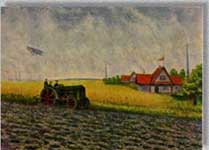 |
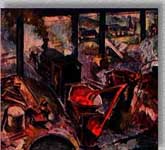 |
Most naturally the Association of the Artists of the Revolution paid great attention to the image of the "new man" and, especially, to the image of the "new Soviet woman" who was depicted as "engineer", "worker promoted to an administrative position", "athlete".
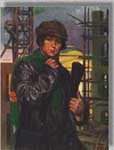 |
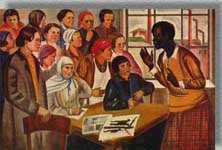 |
A considerable share of these postcards was intended for children. Children depicted on them looked very serious: they played in order to adapt to their future occupations, members of the children's Young Pioneers' Organization in their summer camps not only relaxed but were also engaged in useful labour. The ideal postcard was, by means of its subject, to carry on propaganda intended to promote the development of the new socialist culture.
The press of the Association of the Artists of the Revolution did not use to published only the postcards designed by the members of the Association. Several postcards reproduced paintings from the collection of the Hermitage. Some of the best postcards published by the Association of the Artists of the Revolution were designed by the artists who belonged to the competing association - the Association of Easel Painting. Its members also turned to the novel subjects related to the new Soviet way of life and tried to develop a modern, severe and precise style of painting.
The exhibition also displays the postcards published by the other artists' association - The Moscow Artists' League. The number of postcard titles it published and the amounts of printed copies which were between 5 000 and 25 000 were greatly inferior to those of the postcards published by the Association of the Artists of the Revolution. The Moscow Artists' League elaborated its style along different lines rejecting "naturalistic representation of low everyday life subjects". The artists from the Moscow Artists' League depicted contemporary life and resolved problems of painting techniques succeeding in imparting to the colours of their paintings luminous quality and buoyancy. Landscapes and still-lives were their favorite subjects.
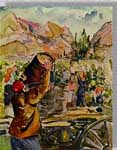 |
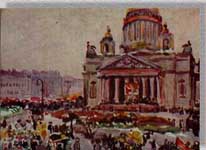 |
Over 250 items from the collection of the postcards published by the Association of the Artists of the Revolution and the Moscow Artists' League created by the National Library of Russia have been selected for display at the exhibition organized in the Printed Graphics Department. For the most part they wound up in the Library's collection during the period from 1929 to 1933 as legal deposit copies. These postcards allow to examine colour reproductions of the works of both forgotten and celebrated artists which have never been reproduced in art books and illustrated monographs. These postcards published by the Association of the Artists of the Revolution and the Moscow Artists' League collected together recreate the cultural atmosphere which reigned in the late 1920s - early 1930s, the tragic and critical years in Russian history.
Postcards published by the Association of the Artists of the Revolution:
E.M. Shegal. Skimming Dross. 1930.
F.A. Modorov. Laying Railroad Rails. The 1930s.
A.G. Zolotariov. Progress of Agriculture. 1930.
V.S. Pshenichnikov. A Street in Samarkand. 1929.
N.I. Shestopalov. A Woman-Engineer. 1930.
Filosofova. Builders-To-Be. 1930.
A.G. Platunova. Delegates' Meeting. The 1930s.
A.A. Deineka. Basketball. 1930.
Postcards published by the Moscow Artists' League:
S.I. Lobanov. Collective Vineyards in the Crimea. 1933.
A.V. Lentulov. Leningrad. The Anti-Religious Museum.
Alina Yartseva
